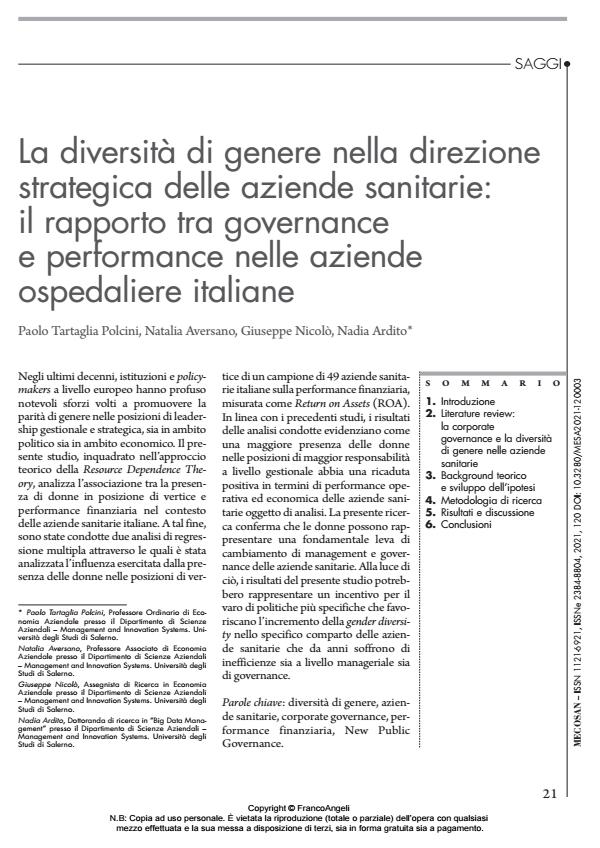La diversità di genere nella direzione strategica delle aziende sanitarie: il rapporto tra governance e performance nelle aziende ospedaliere italiane
Titolo Rivista MECOSAN
Autori/Curatori Paolo Tartaglia Polcini, Natalia Aversano, Giuseppe Nicolò, Nadia Ardito
Anno di pubblicazione 2022 Fascicolo 2021/120
Lingua Italiano Numero pagine 23 P. 21-43 Dimensione file 264 KB
DOI 10.3280/MESA2021-120003
Il DOI è il codice a barre della proprietà intellettuale: per saperne di più
clicca qui
Qui sotto puoi vedere in anteprima la prima pagina di questo articolo.
Se questo articolo ti interessa, lo puoi acquistare (e scaricare in formato pdf) seguendo le facili indicazioni per acquistare il download credit. Acquista Download Credits per scaricare questo Articolo in formato PDF

FrancoAngeli è membro della Publishers International Linking Association, Inc (PILA)associazione indipendente e non profit per facilitare (attraverso i servizi tecnologici implementati da CrossRef.org) l’accesso degli studiosi ai contenuti digitali nelle pubblicazioni professionali e scientifiche
Negli ultimi decenni, istituzioni e policymakers a livello europeo hanno profuso notevoli sforzi volti a promuovere la parita di genere nelle posizioni di leadership gestionale e strategica, sia in ambito politico sia in ambito economico. Il presente studio, inquadrato nell’approccio teorico della Resource Dependence Theory, analizza l’associazione tra la presenza di donne in posizione di vertice e performance finanziaria nel contesto delle aziende sanitarie italiane. A tal fine, sono state condotte due analisi di regressione multipla attraverso le quali e stata analizzata l’influenza esercitata dalla presenza delle donne nelle posizioni di vertice di un campione di 49 aziende sanitarie italiane sulla performance finanziaria, misurata come Return on Assets (ROA). In linea con i precedenti studi, i risultati delle analisi condotte evidenziano come una maggiore presenza delle donne nelle posizioni di maggior responsabilita a livello gestionale abbia una ricaduta positiva in termini di performance operativa ed economica delle aziende sanitarie oggetto di analisi. La presente ricerca conferma che le donne possono rappresentare una fondamentale leva di cambiamento di management e governance delle aziende sanitarie. Alla luce di cio, i risultati del presente studio potrebbero rappresentare un incentivo per il varo di politiche piu specifiche che favoriscano l’incremento della gender diversity nello specifico comparto delle aziende sanitarie che da anni soffrono di inefficienze sia a livello manageriale sia di governance.
Parole chiave:diversita di genere, aziende sanitarie, corporate governance, performance finanziaria, New Public Governance.
- Les pressions institutionnelles influencent-elles la divulgation d’informations sociales et environnementales en ligne dans les organismes de soins de santé italiens ? Diana Ferullo, Francisco Javier Andrades-Peña, Giuseppe Nicolò, Natalia Aversano, in Revue Internationale des Sciences Administratives /2025 pp.517
DOI: 10.3917/risa.913.0517 - The effect of board gender diversity on financial and non-financial performance: evidence from Italian public universities Natalia Aversano, Giuseppe Nicolò, Diana Ferullo, Paolo Tartaglia Polcini, in Public Money & Management /2023 pp.679
DOI: 10.1080/09540962.2023.2243389
Paolo Tartaglia Polcini, Natalia Aversano, Giuseppe Nicolò, Nadia Ardito, La diversità di genere nella direzione strategica delle aziende sanitarie: il rapporto tra governance e performance nelle aziende ospedaliere italiane in "MECOSAN" 120/2021, pp 21-43, DOI: 10.3280/MESA2021-120003